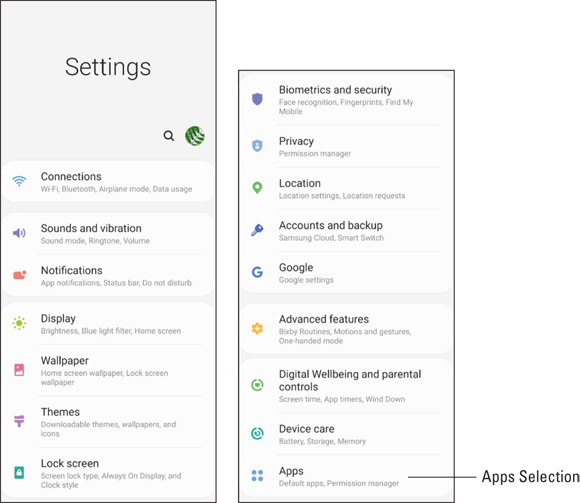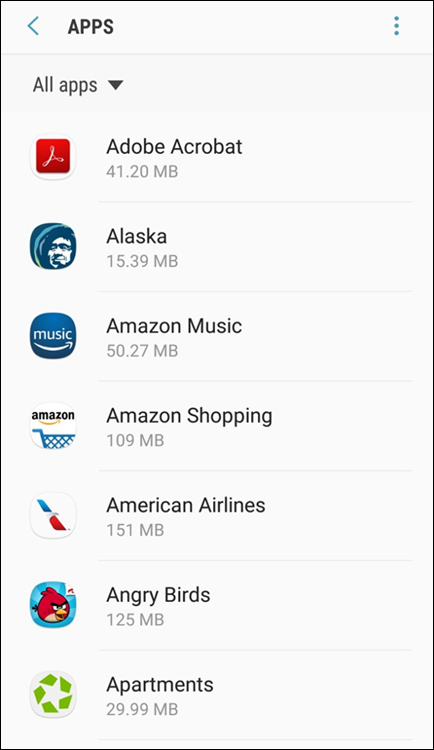Chapter 7
You’ve Got the Whole (Web) World in Your Hands
IN THIS CHAPTER
![]() Surfing the Internet from your phone
Surfing the Internet from your phone
![]() Changing the browsing settings
Changing the browsing settings
![]() Visiting websites
Visiting websites
![]() Adding and deleting bookmarks
Adding and deleting bookmarks
If you’re like most people, one of the reasons you got a smartphone is because you want Internet access on the go. You don’t want to have to wait until you get back to your laptop or desktop to find the information you need online. You want to be able to access the Internet even when you’re away from a Wi-Fi hotspot — and that’s exactly what you can do with your Galaxy S20 phone. In this chapter, I show you how.
The browser that comes standard with your Galaxy S20 works almost identically to the browser that’s currently on your PC. You see many familiar toolbars, including the Favorites bar and search engine. And the mobile version of the browser includes tabs that allow you to open multiple Internet sessions simultaneously.
This chapter goes into much more detail on using the Internet browser on your Galaxy S20, as well as the websites you can access from your phone, and discusses some of the trade-offs you can make when viewing a web page.
Starting the Browser
You have three options for getting access to information from the Internet via your Galaxy S20 phone. Which one you use is a personal choice. The choices are
- Use the regular web page. This option involves accessing a web page via its regular address (URL) and having the page come up on your screen. The resulting text may be small.
- Use the mobile web page. Almost all websites these days offer a mobile version of their regular web page. This is an abbreviated version of the full website that can be more easily read on a mobile device.
- Find out whether a mobile app is associated with the web page. Many websites have found that it is most expedient to write a mobile application to access the information on its website. The app reformats the web page to fit better on a mobile screen — a convenient option if you plan to access this website regularly. I cover the trade-offs about this option later in the section “Deciding Between Mobile Browsing and Mobile Apps” and explore how to find and install such apps in Chapter 8.
With this background, head to the Internet. On your Galaxy S20 phone, you may have a few choices on how to get there. Figure 7-1 shows three possible icons that can get you there. Tap any of these, and you can start surfing.

FIGURE 7-1: Possible paths to the Internet on your Galaxy S20.
If you want a little more understanding as to why there are multiple options, read the nearby sidebar on Internet terminology.
For your purpose, tap either the Chrome icon or the Google icon to get started. These icons will typically be on the Home screen. Alternatively, tap the Application icon and find the Chrome or Google icon.
As long as you’re connected to the Internet (that is, you are either near a Wi-Fi hotspot or in an area where you have cellular service), your home page appears. If you tap the Google icon, it will be Google. If you tap Chrome, your default home page could be blank or the Google home page, but many cellular carriers set their phones’ home pages to their own websites.
If you’re out of coverage range or you turned off the cellular and Wi-Fi radios because you turned on Airplane mode, you get a pop-up screen letting you know that there is no Internet connection. (Read about Airplane mode in Chapter 2.)
Accessing Mobile (or Not) Websites
The browser on your phone is designed to work like the browser on your PC. At any time, you can enter a web address (URL) by tapping the text box at the top of the screen. You can try this by typing in the address of your favorite website and seeing what happens.
For example, the page shown in Figure 7-2 is the regular version of the website Refdesk.com.

FIGURE 7-2: The regular version of the website Refdesk.com.
As you can see, the website is all there. Also as you can see, the text is very small. This particular website is designed to take you to a lot of useful links throughout the Internet, so this is an extreme example of a regular website.
While this text is crisp and bright on your beautiful screen, it is still small. You can stretch and pinch to find the information you need. (Stretching and pinching are hand movements you can use to enlarge/shrink what you see onscreen, as covered in Chapter 2.) With a little bit of practice, you can navigate your familiar websites with ease.
The other option is to find the mobile version of a website. As a comparison, Figure 7-3 shows the mobile version of Refdesk.com. It has fewer pictures, the text is larger, and the mobile version loads faster — but it’s less flashy.

FIGURE 7-3: The mobile version of Refdesk.com.
So how do you get to the mobile websites? If a website has a mobile version, your phone browser will usually bring it up without your having to do anything. Samsung has gone out of its way to make the web experience on the Galaxy S20 phone as familiar as possible to what you experience on your PC.
The most common difference between the address of a mobilized website and a regular one is /mobile.com at the end of the address. For example, the mobile version of Amazon.com is www.amazon.com/mobile.
If your phone doesn’t automatically bring up the mobile version of a site for some reason, the simplest way to find it is to search for the desired site along with the term mobile. For example, the first option you get from searching for IMDb mobile on your phone is the mobilized website for the Internet Movie Database.
Choosing Your Search Engine
If you tapped one of the icons shown in Figure 7-1, you opened up the browser. Now would be a good time to try some of your favorite websites. Go ahead and tap in a few website addresses and see how they look!
One of the early goals for browsers that work on smartphones was to replicate the experience of using the Internet on a PC. For the most part, the browsers on your phone achieve that goal, even if you probably need to practice your zooming and panning.
One of the key decisions for your browser is which search engine you want as the default. You probably want whatever is the search engine that exists on your desktop PC. The leading options are all really good, but you’ll probably be happiest with the search engine that you use the most. If you don’t care, feel free to skip to the next section on bookmarks.
-
From the browser screen, tap the Settings icon.
Tapping the Settings icon, the icon that looks like a gear, brings up the menu options shown in Figure 7-4.

FIGURE 7-4: The Settings Menu options.
-
Tap the Apps link.
Tapping the Apps link brings up the screen shown in Figure 7-5.

FIGURE 7-5: The Apps screen.
-
Tap the three vertical dots on the top right.
The screen shown in Figure 7-6 appears.

FIGURE 7-6: The Apps menu pop-up.
-
Tap the link for Default Apps.
The screen shown in Figure 7-7 appears.

FIGURE 7-7: The Default Apps selections.
-
Tap the link for Browser App.
The screen shown in Figure 7-8 appears.
-
Select the search engine you want.
Tapping the toggle switch by the name of the search engine you prefer takes care of it all.

FIGURE 7-8: The Search Engine selections.
Deciding between Mobile Browsing and Mobile Apps
When you open the browser, you can use any search engine you want (for example, Bing or Yahoo!). This is a very familiar approach from your experience with PCs. However, you may get very tired of all the pinching and stretching of the screen.
Many companies are aware of this. What they have done is to develop a mobile app that provides you the same information as is available on their website that is formatted for a smartphone screen. Companies in particular will put the information from their website in a mobile app and then add some important mobile features.
For example, it is very convenient to order a custom-made pizza from the website of a national pizza chain. You can order your desired variety of crusts and toppings. The website version also offers directions to the nearest store. The mobile app can take this one step further and give you turn-by-turn directions as you drive to pick up your pizza.
This capability of providing turn-by-turn directions makes no sense for a desktop PC. This capability could make sense for a laptop, but a few laptops have GPS receivers built in. It is also too cumbersome and probably unsafe to rely on turn-by-turn directions from a laptop. It is much easier to get turn-by-turn directions over a smartphone.
This is just one example where downloading a mobile app offers a superior experience. The best part is you get to choose what works for you on your Galaxy S20.

 If you love Bing, you are not out of luck. Bing is either on your phone, or you can get it installed (I cover how to install things like Bing in
If you love Bing, you are not out of luck. Bing is either on your phone, or you can get it installed (I cover how to install things like Bing in